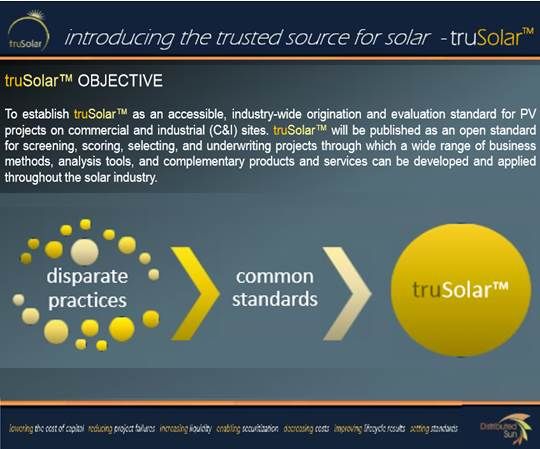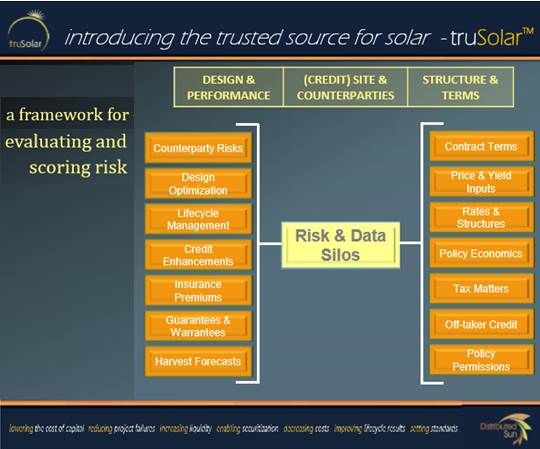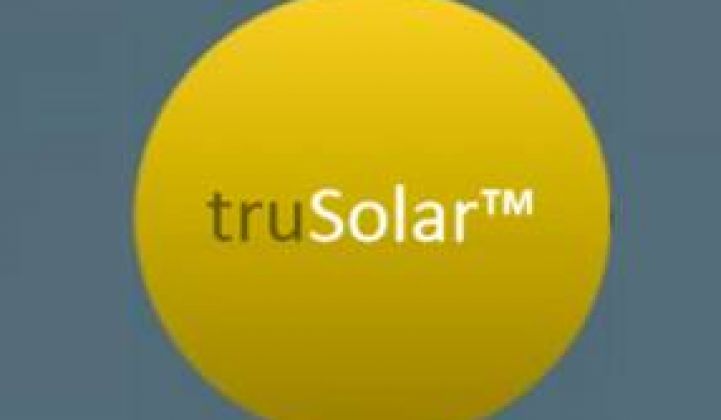Fewer than 5 percent of the 6,500 banks in the U.S. will finance solar. Yet bankers who work in solar tout the asset’s excellence. A new industry consortium of solar's leading players wants to make it easier for the remaining 6,200 banks to get in the game.
Banks don’t look at loans for solar projects because, leaders of the truSolar™ initiative said in a special session at Solar Power Generation 2013, the nascent industry lacks standards adequate to make the notoriously financially conservative bankers confident of a return on their investments. truSolar would create a score -- something like a credit rating -- for each solar project.
With standardized ratings for every significant element in a project, from component quality to the developer’s track record to the regulatory expediency of the project’s jurisdiction, a project would earn a truSolar score that would tell financial institutions and investors what its relative risk is.
With industry-wide standards and rankings for asset manufacturers, developers, installers, managers, funders, and regulatory procedures, and standardized forms and contracts, the risk associated with loans would be reduced because lending institutions could be more confident of the predicted performance of the systems they invest in. This could increase the flow of money to the solar industry while cutting transaction costs and the cost of capital.
Establishing such standards would also attract insurance and ratings agencies, further increasing liquidity and volume. Riskier projects would be rated lower and charged higher interest rates by lenders and higher insurance premiums by risk adjusters.

“If you have a project that is going to need a lot of care to even get across the finish line, my premiums are going to be higher because of the risks involved,” explained truSolar partner and solar project insurer Assurant's VP David Schroeder. “You are condensing not only insurable risk but all the aspects of risk into a score.”
“The bankers have said they have a quality problem,” explained Ian Gregory, Managing Director at panel quality specialist SolarBuyer. “They don’t understand where the issues are, but they know they can no longer rely on traditional methods of evaluation.” SolarBuyer European Managing Director Peter Rusch speculated that well over half the banks in Germany lend to solar.
“In my experience in international finance,” agreed Assurant’s Schroeder, “German banks were a common occurrence in the renewable space.” One of the important things truSolar could do, he acknowledged, would be to bring the resources of a comparable portion of U.S. banks into play.
During the conference, Hertz (NYSE:HTZ) Environmental Director Susan Pinera said her company had run into only the normal obstacles of construction during its ongoing development of rooftop commercial projects. But, she stressed, Hertz had done its due diligence. That is exactly the effort truSolar would minimize for lenders and insurers.
“Standardization,” said Sungevity President Danny Kennedy, “is necessary to get big money comfortable.”
Where Solar Mosaic CIO Greg Rosen now has two analysts working 30 hours on project due diligence, the solar financier said, standardization would allow him to have them working only three hours because the project's score would be pre-established.
“The cost of capital and risk premiums are misaligned and capital is overpriced,” said consortium member PanelClaw’s CEO Costa Nicolau. “Even the banks in the space spend too much time [trying to] understand the space. And since there is no standard, they understand it differently.” As a result, Nicolau said, “the commercial and industrial PV market in the U.S. is grossly underexploited. And mispriced.”
In the current environment, truSolar advocates say, bad projects may be paying too little for capital and risk mitigation and good projects may be paying too much.

An industry consortium effort led to standards in the cell phone sector, said Distributed Sun's Senior VP Doug Payne. It started with internal conversations at Distributed Sun about bankability. Inundated by proposed projects’ inconsistencies, they coined the term "truSolar" to describe the standardization they wanted.
Talks with representatives of DuPont (NYSE:DD) Photovoltaic Solutions about their Materials Matter initiative advanced the idea. In September 2012, Payne said, Distributed Sun, DuPont and the Rocky Mountain Institute introduced the truSolar initiative at Solar Power International.
Looking ahead, Payne said, he sees an alpha tool for internal testing in six months to nine months, followed by perhaps twelve months of beta testing. Twelve to eighteen months later, the consortium hopes -- pending working group consensus -- to do a full open-source release to the industry.
The best analogy, though not a perfect one, Payne said, is a sort of Kelley Blue Book for Solar. Other industries have “a standardized set of forms, terms, conditions, documents, scoring and rating that all play off a common backbone or framework.”
“A developer would put together a project,” Payne said. “The terms, pricing, technologies and other factors would earn the project a truSolar score. Based on that score, rating agencies such as Standard and Poor’s -- which is part of the consortium -- could rate that project. That rating would generate the developer’s cost of capital and a risk mitigation premium.”
Other members of the consortium include ABB (NYSE:ABB), Booz Allen Hamilton (NYSE:BAH), National Renewable Energy Labs, Sandia National Labs, and SMA America.



